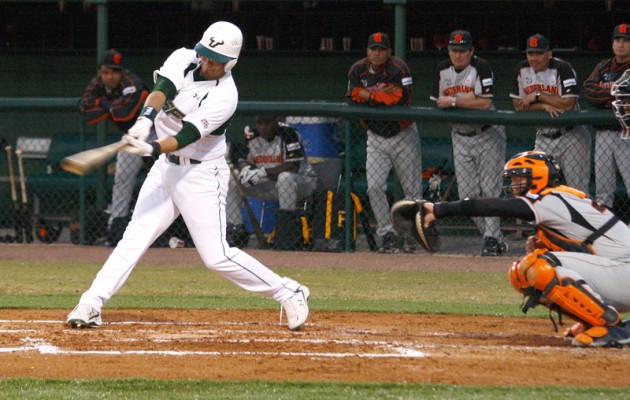Coming back

Brandon Smith battled for a spot in the Bulls’ lineup and finished with a .288 batting average in 37 games last season.
However, he fought a far more serious battle soon afterward.
The 6-foot tall, 195-pound USF infielder developed a blood clot and was diagnosed with subclavian deep venous thrombosis in his right arm, putting his baseball career in jeopardy.
The diagnosis was just the beginning, though. Doctors learned the clot was caused by a much deeper problem: thoracic outlet syndrome (TOS).
Murray Shames, Smith’s vascular surgeon, said the blood clot caused the initial pain and discomfort but was a side effect of TOS.
Smith, who joined the USF baseball team in 2008 after transferring from Sacramento City College, was left in doubt about whether he could continue playing the game he loves.
Safe or out?
After a workout last season, Smith noticed his right shoulder was swollen to almost twice its normal size.
USF athletic trainer Corey Tremble said he thought it might be a tear in Smith’s pectoral
muscle.
Like many athletes, however, Smith played through the discomfort.
“If I knew it was a blood clot, I probably wouldn’t have played as long as I did and would have gotten it fixed a lot sooner, but that’s the way I am,” Smith said. “I guess I just dealt with the pain and tried to play as long as I could.”
After USF doctors evaluated him, Smith had the first of eight surgeries.
But it wasn’t just about fixing the blood clot, Shames said. The TOS had to be treated.
“It’s an injury that can happen to veins, arteries and nerves in the neck area,” he said. “The vein gets crushed and it develops from repeated injury over the years.”
Smith’s collarbone and first rib were habitually crushing his vein, constricting it and blocking blood flow.
“I dissolved the clot first,” Shames said. “Then I opened the thoracic outlet to take out the rib to create more space for the vein.”
Smith said he felt fine the morning after surgery — but by lunchtime, it was a different story.
“I couldn’t breathe very well,” he said. “It was probably the most pain I had been in.”
The procedure gave Smith the chance to play baseball again without risking another clot. However, more problems occurred later.
“I was in the ICU for a while, maybe five days,” Smith said. “I had complications a few days out of surgery. I had two liters of blood leak into my lung.”
During that time, Smith was on blood thinners to keep the blood flowing though his arm and to prevent another clot, but Shames said his vein narrowed again and caused one anyway. Smith was now in a fight for his life.
Doctors inserted a chest tube to drain the blood. Shames performed another surgery and Smith was given a blood transfusion. He remained in the intensive care unit at Tampa General Hospital.
While Smith was in the hospital, he thought of baseball. He said it was hard for him to sit back while his team was on the field. A California native, Smith doesn’t have family in Florida. However, his second family — the USF coaches and players — kept him company.
“We were trying to get his mind off the pain and everything he went through,” said coach
Lelo Prado.
On May 7, Smith was removed from the ICU. On May 9, 18 days after his initial diagnosis, Smith was released from the hospital, taking his first step toward
rehabilitation.
Shames then referred Smith to a vascular surgeon in St. Louis, Dr. Robert Thompson, who has performed preventative surgeries on major league baseball players.
Getting back
Smith took the entire 2008 off season to try and get back on the field. But getting back was a lot of work.
He lost about 30 pounds while in the hospital and said the hardest part of rehabilitation was getting his strength back.
“Everything for the first couple of weeks was such a task and a chore,” he said. “I couldn’t lie down for while without struggling to breathe.”
With hard work, he battled his way back into USF’s lineup.
Smith has played in eight games this season for the Bulls. He said he tries to keep his mind off his past.
“I just try to listen to everybody’s input, know certain things to stay away from, certain things to do to help keep the clot from forming,” he said. “I stay flexible and keep my shoulder stretched out — that’s key for me.”
Prado said if Smith can stay healthy, he could be the starting first baseman.
“I’ve got to be careful early, because he goes 150 miles per hour,” Prado said. “So I have to make sure he doesn’t get hurt right off the bat.”
Life after baseball
While baseball is still a top priority, the injury made Smith think about his future. His goal for this season is not to hit 30 home runs or be recognized as an All-American, but rather to get his bachelor’s degree in criminology.
“It’s always been my dream to sign and continue playing at the next level,” Smith said. “I would say this injury has put that whole goal on the back burner for the most part.”
He said he’s just enjoying playing the game again.
“Don’t worry about today, because you never know when it’s going to be taken away from you again,” he said.






